myths of autumn
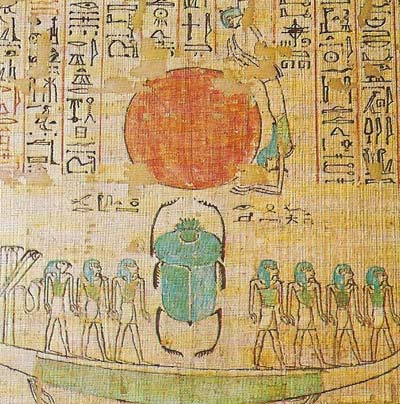
Figure 1. The rising sun in Egyptian mythology is symbolized by the scarab beetle Khepri, here being lifted out of the primeval waters (from an 1150 BC papyrus). The Book of the Dead tells how the soul, in its journey through the under-world, reaches the divine solar barque where it can ask the god freely about the reasons for all the apparent disharmonies it has met during its lifetime. The scarab's habit of providing larval food by laying its eggs in a ball of dung (regarded by the Egyptians as a symbol of the world) made it seem eternally self-creating. In its cyclic decline, the sun-god was known as Re-Atum, or "the completed".
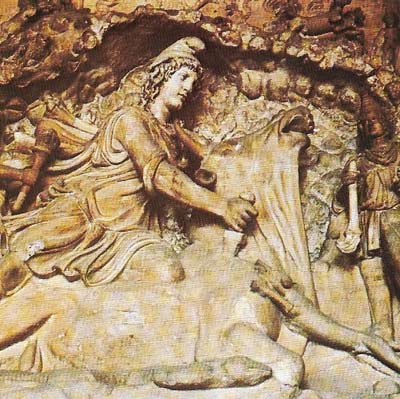
Figure 2. Mithraism was practiced as a religion in Asia Minor centuries before Christ and was taken up as a cult by the Romans about AD 75 as a competitor to Christianity for some 200 years. An important element is the bull sacrifice demanded by the sun-god, Mithras, who is also the bull – slayer and slain. The sacrifice marks a state of transition similar to seasonal changes. It ensures fertility and purifies the human soul. The bull suffers; even the god has to avert his eyes. But from the various parts of the newly sacrificed animal a whole cosmos is miraculously created.
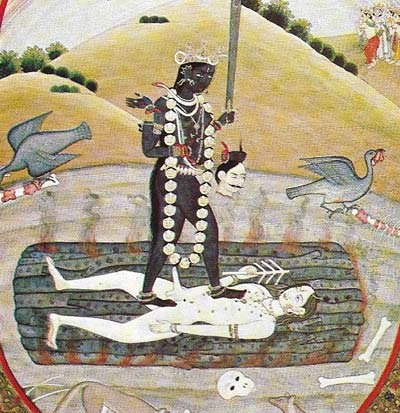
Figure 3. As life feeds on life, so the beautiful young maiden Parvati changes into the death-dealing Hindu goddess Kali, seen here dancing on her husband, Shiva. What the goddess has bestowed, she will take away. She is the Black One, suit-ably adorned with a necklace of skulls. Often, she is shown brandishing scissors as well as a sword with which to cut the thread of life. Dishevelled and wild-eyed, with large fangs, protruding tongue and blood-dripping hands, she nevertheless embodies Shiva's dynamic energy, even when dancing on his corpse. The word Kali is the feminine for "time" and is a reminder of the brief lifespan of every-thing in existence.
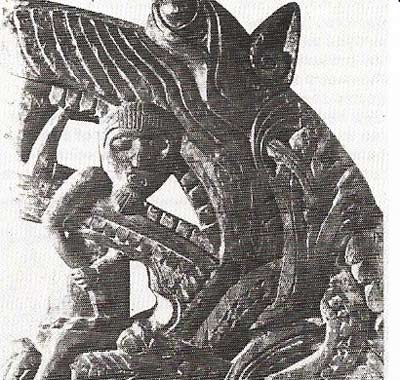
Figure 4. The cycle of life and death does not spare the gods of Scandinavian mythology, who are destroyed by monsters at the end of their rule. Here Odin is being devoured by the wolf Fenris. The twilight of the gods reflects the onset of the Nordic winter. But the gods are avenged by their sons. The wolf is slain by Odin's son and a new generation of men and women arise from the world tree, Yggdrasil.
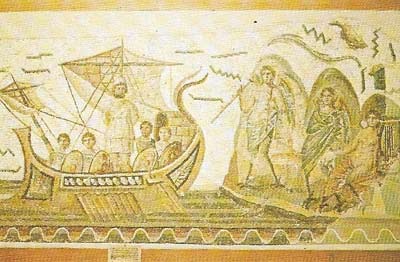
Figure 5. Odysseus's encounter with the Sirens (from a Roman mosaic) during his return home after the fall of Troy is typical of threatening myths about women. The Sirens were beautiful maidens whose singing so enchanted sailors that they swam ashore and died miserably. Odysseus filled his rowers' ears with was and had himself bound to the mast so that he could hear the sweet singing without diving overboard to his death.
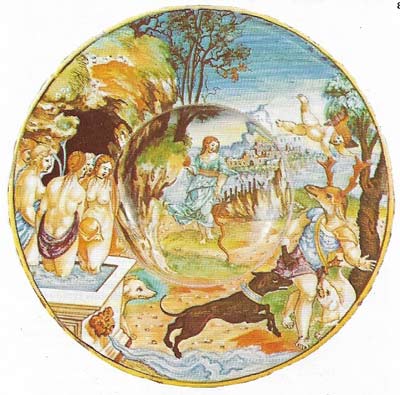
Figure 6. The Greek myth of Actaeon being killed by hounds reveals a goddess in savage mood. Actaeon was hunting a stag when he caught sight of Diana (or Artmeis) bathing with her maidens. In anger, she transformed him into his own quarry to be torn to pieces. It is superficially the story of a virago punishing a man's lust. But the stag was a sacred animal and Actaeon's ritualistic dismemberment perhaps implied an autumnal sacrifice to ensure the next harvest.

Figure 7. Vishnu, the great Hindu god, can take on whatever incarnation (dvatas) is required. Three of the best known are in animal form: fish, tortoise, and boar. During the Flood, man's ancestor, Manu, was saved by a fish whose life he had spared (Vishnu in disguise). The motif of a grateful animal saving the hero's life is well known in Western fairy tales and is perhaps as universal as the story of the Flood among the various myths of destruction.
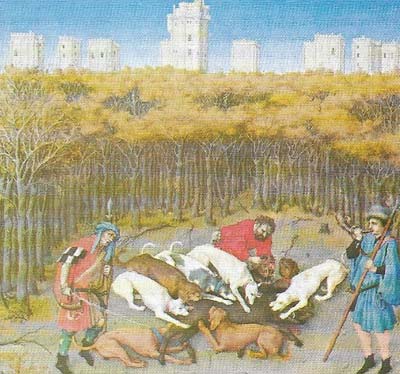
Figure 8. Mythological themes of death, mourning, and dismemberment are summed up in a medieval scene of the end of a day's hunting with the death of the stag and trees in autumnal colors.
Autumn, when the fertility and vigor of summer give way to the death of crops and the failing strength of the sun, is associated in mythology with the dying god or hero (Figures 2, 4 and 6), the destructive power of the mother goddess (Figures 3 and 5) and the death or peril of the earth and the creatures it supports.
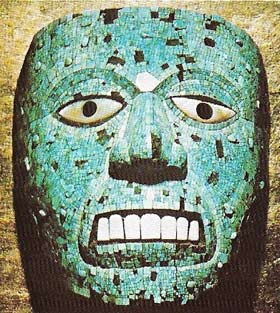 |
| This Aztec mask, covered in turquoise, is believed to represent Tlaloc (or the Mayan Chaac). Although not a major deity in the Aztec pantheon, as the god of rain he was of considerable importance in the dry, hot climate of Mexico. His cult was the most horrible of all. For the festival in his honor, the priests sacrificed babies and young children which they afterward cooked and ate. If the children cried it was a sign of rain to come. |
The cycle of the seasons
The Greek story of Demeter and her daughter Persephone shows how myth tries to answer the central questions of life – in this case why the earth annually loses its fertility and nature apparently dies.
The god Zeus was both the father and uncle of Persephone. Without Demeter's knowledge he promised Persephone to his brother Hades (king of the underworld). While the girl was gathering flowers in the fields of Nysa, the earth suddenly opened and Hades carried her off. When she learned what had happened, Demeter, angry with Zeus, left Olympus and as a result, since she was the goddess of fertility, the earth was barren and nothing grew. Famine would have destroyed all creatures had not Zeus sent Hermes to fetch Persephone back. Hades consented, but he had already given her a pomegranate to eat. Because she had eaten in the underworld she would have to spend a third of the year below the earth. The rest of the year she could spend happily reunited with her mother, who consequently allowed the earth to bear fruit again.
In this myth of fertility and death, Persephone in Hades is the seed corn in the ground; Persephone rejoined with her mother is the sprouting seed that nourishes man and animals. To mark the annual cycle, to make sure that it continued and to propitiate the goddess, a festival, the Eleusinia, was celebrated in Athens, as harvest festivals are in other parts of the world.
In addition to explaining the succession of the seasons, myths are concerned to explain shorter cycles such as the rising and setting of the sun (Figure 1) and the phases and eclipses of the moon. In Indo-European myths the orbits of the sun are often interpreted in terms of a horse and chariot. Surya, the Hindu sun-god, for instance, drove across the heavens in a flaming chariot, as did the Greek Helios and the Slavonic Dazhbog. A Nordic version explains that the sun and moon move because they are being pursued by devouring wolves.
In India the moon represented the cup from which the gods drank Amrita, the elixir of immortality, and its eclipses were due to the monster Rahu. When the gods first extracted Amrita, by churning the Milk Oceans, Rahu stole the first sip. Vishnu immediately cut off his head, which began to pursue the moon ravenously. Eclipses happened when Rahu succeeded in swallowing the moon, but because he had no stomach the moon reappeared and the chase across the heavens was resumed.
Myths of the flood
Floods as periodic, world-destructive events occur so universally in myths that they may reflect actual events, although it is probable that many local inundations were interpreted as world events. The bare bones of these myths are the same. A great flood drowns all the inhabitants of the world with the exception of one man or family whose escape in a boat is made possible by advance warning. Eventually the gods are appeased, the floods recede and life reappears.
But there are interesting variants. In the Hindu version Manu, unlike the Hebrew Noah, was the only survivor because he had been warned of the flood by a fish (Fig 7). When it was all over he felt lonely and wanted a wife. She was duly created by the gods who made her out of Manu's sacrifices of sour milk, butter and curds.
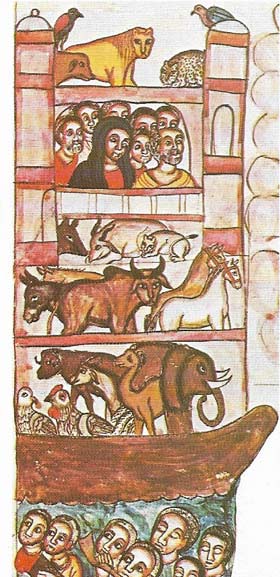 |
| This multistoried ark, from an 18th-century Ethiopian text on Noah, carries all the creatures need to repopulate the world when the Flood finally subsides. Central to the flood myth is a warning to mankind not to be too proud. |
In the Mesopotamian Epic of Gilgamesh the survivors of the flood, Utnapishtim and his wife, had similar experiences but their relationship with the gods was not as personal as that 'between Noah and Yahweh. For one thing Utnapishtim was warned only by a subterfuge of Ea, lord of the waters and wisdom, who by doing so gave away a secret plan of the council of the gods. Nor was there afterwards, any promise by the gods that such a disaster would not happen again.
The coming of death
It is not surprising that death, the ultimate mystery of life, should be a universal theme in mythologies. Death is consistently seen as an intruder, not existing at the beginning when humans renewed their lives repeatedly as did snakes their skin or the moon in its phases. Usually, death appears as a result of an error, as a punishment, or by agreement.
The idea of death as an error often centers on a message that goes astray. In Africa, for instance, God sends the chameleon to tell the first men that they are to be immortal. But because it dawdles it is overtaken by the lizard, who is the messenger of death.
Death as a punishment (often because of a woman's fault, as in the biblical story of Adam and Eve) is a common motif. The Algonquin Indians of North America, for instance, held that the Great Hare gave man immortality in a parcel that he was forbidden to open. His wife, being curious however, looked in and let immortality fly away.
Death by agreement appears in some parts of the world. A myth of the Greenland Eskimos states that in the beginning there was no death but also no sun. One old woman insisted that if it was impossible to have one without the other, it would be better to have both, as without light, life was worthless.
